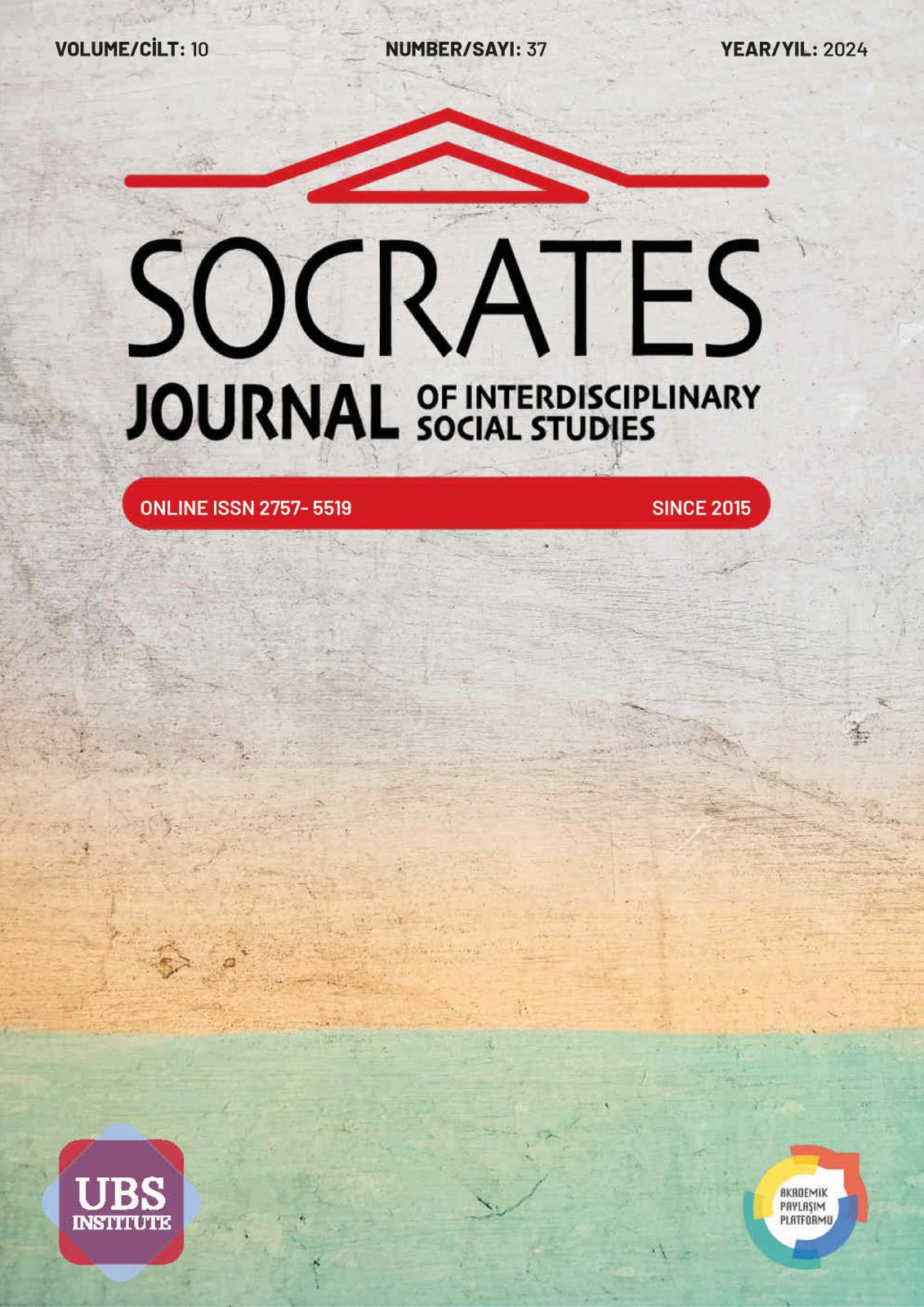SIMULATE FAME THAT HAS TURNED INTO COMMERCIAL META KIDS YOUTUBERS
DOI:
https://doi.org/10.5281/zenodo.10498321Keywords:
Dijital Şöhret, Tüketim Kültürü, Simülasyon KuramıAbstract
With the increase and popularity of individuals meeting in virtual technology, the concepts of digital fame or virtual fame have emerged and a rapid increase has been seen in the number of new phenomena of social media due to economic gains and expanding fame. Curiosity to be known and popular is a feeling that comes from a will that arises from one's ego. This situation is observed from children to the elderly, regardless of age. In recent years, virtual famous phenomena have emerged due to the rise of the Youtube application and the possibilities of financial gain from being a youtuber. Today, digital fame is diverse. It is seen not only on Youtube, but also in social media applications such as Instagram, Facebook. The Millennium Age has brought with it the digital age. Now, it is claimed that the Digital World - Metaverse Age has arrived. This situation attracts children more. Especially child YouTubers lose themselves in this virtual consumption culture. In fact, parents have become officially blind due to the opportunities provided by digital fame, and they recklessly engage in marketing their children in this medium. The main problem of the X, Y, Z generations is those who are stuck in the transitional age. Especially with the rise of YouTube, which covers the Z generation, "YouTube phenomena" with millions of subscribers have emerged, making digital games, video blogs, fashion and makeup videos. These individuals are generally famous among children and young people and especially affect their peers. They encourage them to produce similar content through social networking channels and also set an example for children to become famous. The things that are done for the sake of increasing the number of subscribers and gaining from this situation are beyond themselves to be predictable. Baudriallard talks about the unreal artificial temporary simulated fame achieved in a short time within the consumer culture. In this context, the study will be shaped within the framework of Baudriallard's simulation theory. A comprehensive and comprehensive approach, which is the comprehensiveness of education within the scope of simulation, a commercial commodity will be presented with the review of the education through videos, a decentralized platform and the continuation of the children in need of adulthood.
References
Akyazı, E. (2015). Siyasal Kutuplaşma ortamı olarak sosyal medya: 7 Haziran 2015 genel seçimleri üzerine bir araştırma”, ağdaki şüphe bir medya eleştirisi. İstanbul: Beta Yayınları.
Akyüz, E. (2010). Çocuk Hukuku. Ankara: Pegem Akademi.
Alper, A. (2012). Sosyal Ağlar. Ankara: Pelikan Yayıncılık.
Avcı, Ö. (2015). Dijital Yaşamın Dijital Özne(l)leri: Herkes ya da Hiç Kimse. Uşak Üniversitesi Sosyal Bilimler Dergisi, 249-266.
Aytaç, Ö. (2006). Tüketimcilik ve Metalaşma Kıskacında Boş Zaman. Kocaeli Üniversitesi Sosyal Bilimler Enstitüsü Dergisi, 27-53.
Baudrillard, J. (2011). Simülakrlar ve Simülasyon. (O. Adanır, Çev.) Ankara: Doğu Batı Yayınları.
Baudrillard, J. (2008). Tüketim Toplumu. Çev., Hazal Deliçaylı ve Ferda Keskin. İstanbul: Ayrıntı Yayınları.
Baudrillard, J. (2010). Sanat Komplosu, (çev. Işık Ergüden- Elçin Gen). İstanbul: İletişim Yayınları.
Baudrillard, J. (2001). Tam Ekran, (çev. Bahadır Gülmez, YKY yayınları, İstanbul
Crystal, A. (2018). Internet Celebrity: UnderstandingFame Online. Jönköping University, Sweden: Emerald Publishng.
Çaycı, B. ve Aktaş, C. (2018). Medya Çağında Weberyen Karizma ve Şöhretin Analojisi. TRT Akademi, 654 - 676.
Dağtaş, B. ve Dağtaş, E. (2009). Medya, Tüketim Kültürü ve Yaşam Tarzları . Ankara: Ütopya Yayınları.
Gardner, H., & Davis, K. (2013). App kuşağı dijital dünyada kimlik, mahremiyet ve hayal gücü. İstanbul: Optimist Yayınları.
Holderman, L. (2007). Ozzy Worked for Those Bleeping Doors with the Crosses on Them’: The Osbournes as Social Class Narrative.”, (Ed: Redmond S.& Holmes S.), Stardom and Celebrity: A Reader. S. Redmond, & S. Holmes içinde, Stardom and Celebrity: A Reader (s. Chapter 24). SAGE Publications Ltd.
Jarvis, J. (2012). E-sosyal toplum. Dijital çağda sosyal medyanın iş ve gündelik hayata etkisi. (çev. Çağlar Kök). İstanbul: MediaCat Yayınları.
Jorge, A., & Marôpo, L. (2017). Childhood and Celebrity . Born to be famousChildren of celebrities and their rights in the media (s. 28-40). içinde London, United Kingdom: Routledge.
Laughey, D. (2010). Medya çalışmaları - teoriler ve yaklaşımlar. İstanbul: Kalkedon.
Marshall, P. D. (1997). Celebrity and power. London: University of Minnesota.
McLuhan, M. (2005). Yaradanımız medya- medyanın etkileri üzerine bir keşif yolculuğu. İstanbul: Turkuvaz Kitap.
Mutlu, B. (2017). Sosyal medya pazarlamasının yeni yüzleri youtube içerik üreticileri ve kanal toplulukları: Youtuber - marka işbirliği videoları üzerine bir araştırma. Yüksek Lisans Tezi, Ege Üniversitesi, İzmir.
O’Connor, J. (2017). Childhood and celebrity. Mapping the Terrain. içinde Routledge.
Omay, U. (2009). Emeğin Kültür ve Manipülasyon Teorisi . İstanbul: Beta Yayınları.
Önk, Ü. (2009). Baudrillard Perspektifinden Bir Kitle İletişim Ve Sanat Aracı Olarak Simülasyon Evreninde Televizyon. Selçuk İletişim, 201-218.
Robb, M. B., & Sense, C. (2020). Teens and The News: The Influencers, Celebrities and Platforms They Say Matter Most. San Francisco: CA: Common Sense Media.
Rojek, C. (2003). Şöhret, (Çev. Semra Kunt Akbaş, K.S. & Kızıltuğ, K.) . İstanbul: Ayrıntı Yayınları.
Ruddick, G. (2017, Ağustos 3). The ‘sharenting’ divide: half UK parents do not post children’s pictures. theguardian: https://www.theguardian.com/uk-news/2017/aug/03/the-sharenting-divide-half-uk-parents-do-not-post-childrens-pictures. adresinden alındı
We Are Social. (2020). Digital in 2020. https://wearesocial.com/digital-2020, 18.12.2021.
Whitehead, D. (2014). The Evidence of Things Unseen: Authenticity and Fraud in the Christian Mommy Blogosphere. Journal of the American Academy of Religion , 120-150.
Ying, H. (2007). Youtube Gerçek Öyküsü . İstanbul: Pegasus Yayınları.
Yüksel, M. (2003). Mahremiyet hakkına ve bireysel özgürlüklere felsefi yaklaşımlar. Ankara Üniversitesi SBF Dergisi, 5-11.
Zolides, A. (2017). Conceptualising the child as media producer. Jane O’Connor ve John Mercer (Ed.), içinde, Childhood and celebrity (s.147-158). Routledge.
https://www.commonsensemedia.org/sites/default/files/uploads/research/20 20_teensandnews-fullreport_final-release-web.pdf, 18.12.2021.
https://www.hurriyet.com.tr/dunya/ne-enes-batur-ne-de-danla-bilic.-prenses-elif-tam-2-5-milyar-kez-izlendi-40752648, 18.12.2021.
https://eksisozluk.com/prenses-elif--5236805?p=1, 18.12.2021.
https://www.youtube.com/watch?v=CMNafxGmycA, 18.12.2021.
https://eksisozluk.com/prenses-elif--5236805?p=1, 18.12.2021.
Downloads
Published
How to Cite
Issue
Section
License
Copyright (c) 2024 Socrates Journal of Interdisciplinary Social Studies

This work is licensed under a Creative Commons Attribution 4.0 International License.


